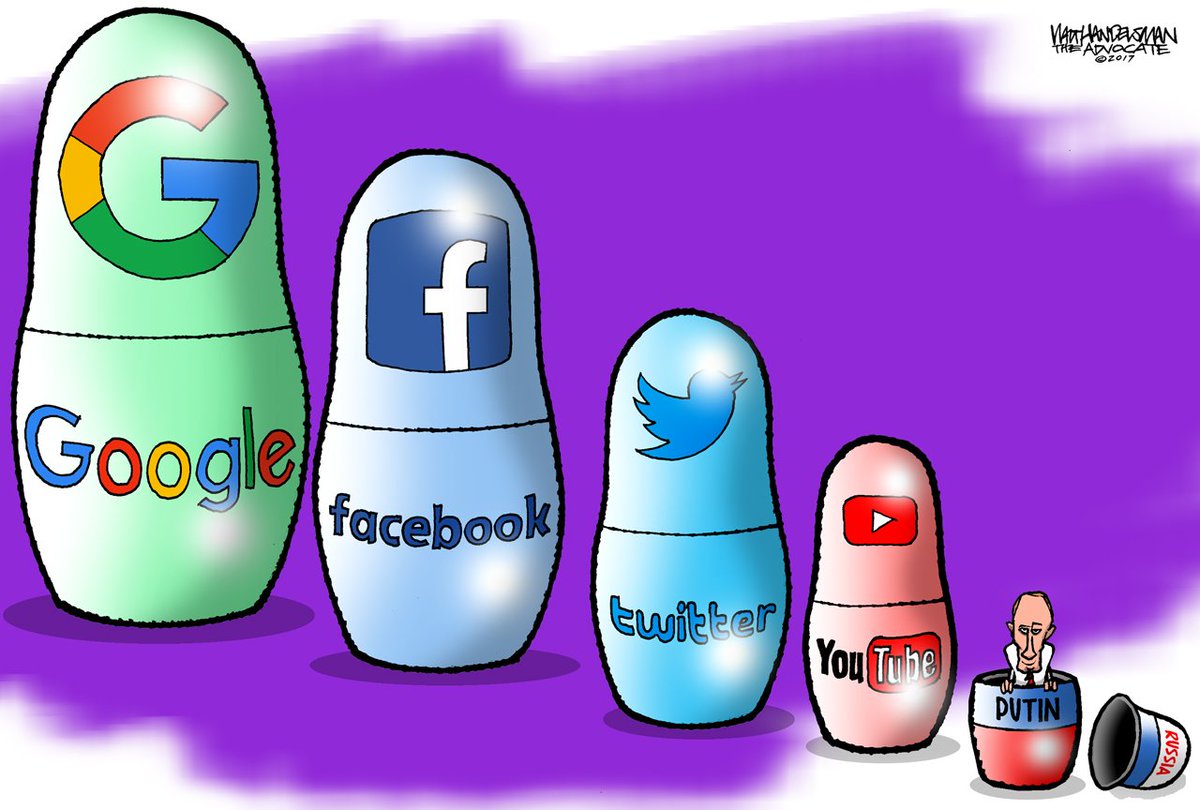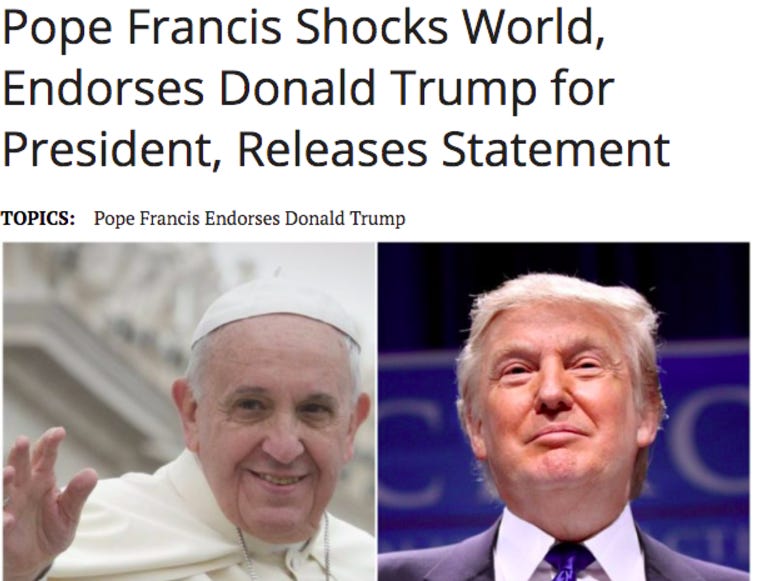How Fake News Affected the 2016 Presidential Election
By Christina Georgacopoulos and Grayce Mores | July 2020

Political misinformation has the potential to change election outcomes.
“Falsehood flies, and truth comes limping after it, so that when men come to be undeceived,
it is too late; the jest is over, and the tale hath had its effect.” -Jonathan Swift, “The Art of Political Lying”
The potential impact of fake news on President Trump’s victory in 2016 is among the most contested controversies of his presidency. Although the State Department has found proof of Russian election interference, whether or not that translated into a win for Donald Trump is still widely argued against and doubted. However, drawing on internet browsing data, archives of fact-checking websites, and results from an online survey, what research findings do show is that:

Where Did Fake News Originate?
Russian trolls are state-sponsored anonymous internet content creators who covertly organize and participate in Russian and international political blogs and internet forums. Russian bots orchestrate large-scale trolling and disinformation campaigns to promote pro-Putin and pro-Russian propaganda. But the goal of Russia’s troll army is less sophisticated than what people think. Instead of promoting a preferred candidate, Russian actors exploit pre-existing divisions in Western societies to stoke outrage, and erode social cohesion and Americans’ confidence in institutions of democracy. America’s controversial history of race relations, growing wealth inequality, and political polarization are fertile ground for Russia to scatter seeds of disinformation and propaganda.
- Internet trolls post inflammatory and digressive, extraneous or off-topic messages in an online community with the intent of provoking readers into displaying emotional responses for a specific gain. Trolling can also mean targeted online harassment.
Russian actors who weaponize information use the same “political warfare” techniques that their Soviet predecessors used over a century ago. Soviet-style “active measures” or psychological warfare techniques include covert media placement, forgery, deploying agents of influence, “friendship” societies, and front organizations.
But disinformation has become an ever-higher art form. The Internet and social media
allow disruption in other countries’ elections on a massive scale never before seen.
In the 2016 U.S. presidential election, a 50,000-strong army of Russian bots promoted
conspiracy theories and fake news by mimicking content that already existed within
far-right and extremist online communities.
A fake doesn't have to be good to be effective. Strategically placed misinformation can sow confusion, doubt and conspiracy theories among voters.
The infamous Pizzagate conspiracy was the work of 12 Russian GRU agents who operated the website DCLeaks that published thousands of hacked emails stolen from the DNC. Far-right extremists on the anonymous internet forum 4chann, who were amplified by Russian bots on Twitter, falsely claimed the hacked emails contained coded messages that showed high-ranking Democratic officials were involved in human trafficking and pedophilia. Russian trolls exploited pre-existing channels to push the conspiracies of fringe extremists into mainstream media coverage.
Guccifer 2.0, a persona donned by Russian hackers, broke into the DNC network to retrieve selectively-provocative emails that bashed then-candidate Sen. Bernie Sanders of Vermont. These emails were published on WikiLeaks on July 22, 2016, three days before the Democratic National Convention with the aim of deepening division in the party between Clinton’s and Sanders’ supporters. The email hack led to the resignation of the party's chair, Rep. Debbie Wasserman Schultz of Florida.
Special Counsel Robert Mueller pursued an indictment of 12 Russian military intelligence officers for hacking the DNC network, further confirming Russian intervention in the 2016 presidential election.
Fake news websites deliberately publish hoaxes, propaganda, and disinformation and use social media to draw attention and drive web traffic. The fabricated stories featured on these websites are intentionally created to mislead readers either for monetary profit, or for more nefarious reasons, such as disinformation campaigns. Fake news creators coordinate disinformation campaigns to coincide with political events--they know that outrageous and extraordinary claims are more likely to be believed during a political crisis
Fake news websites often post clickbait articles that carry exaggerated, misleading, or fake titles as a method to persuade readers to view content on their website. Out-of-context or manipulated images can confer a sense of legitimacy to a website or article.
Fake news websites often use impersonation and pose as legitimate news organizations to gain readers’ trust. Sometimes internet trolls can completely copy an existing website down to its name and authors, and can trick readers into believing the website is an official organization, such as Bloomberg or CNN. com.
Many fake news sites operate under a veil of obscurity whereby the names of authors and reporters are not included or difficult to discern. Fake news creators often use an alias or no name at all.
Typosquatting is a form of internet cybersquatting, which is based on the probability that a certain number of internet users will mistype the name of a popular site while surfing the internet. Typosquatters monitor how many clicks a mistaken domain name receives and uses the data to sell advertising for the sites that receive a high volume of accidental traffic. Another form of typosquatting occurs when fake news websites create a nearly identical domain name to that of a legitimate U.S. news publication. For example, by creating the domain CNNnews.com.co, trolls rely on readers not verifying the address they typed in or clicked on. This occurs frequently on social media where linked articles that are infrequently checked by readers take them to a fake site that appears real.
- During the last three months of the 2016 election, the top 20 fake news stories had 8,711,000 shares, reaction and comments, while the top 20 real news stories only received 7,367,000.
- Approximately 115 pro-Trump fake stories were shared on Facebook a total of 30 million times, and 41 pro-Clinton stories were shares a total of 7.6 million times.
Examples of fake news websites:
- RealTrueNews was created by Marco Chacon to prove to his alt-right friends their gullibility. A fake transcript of one of then-candidate Hillary Clinton’s leaked speeches was reported as factual by Fox News host Megyn Kelly, who later apologized and retracted the story. Other phrases invented by Chacon were also repeated in the news media.
- MediaFetcher.com is a fake news website generator that provides templates for creating false stories about celebrities.
- Huzlers is a satire website that has received criticism for blurring the line between satire and fake news, and has been fact checked by Snopes over 20 times.
- National Report & News Examiner both profited heavily from click-bait articles. The owner reported that he made $10,000 a month through ads linked to fake news. The sites’ articles were so effective because articles appeared legitimate early on, but eventually grew more absurd as the reader progressed through the story.

The Fake News Machine
CNN published a report on the town of Veles, Macedonia, where generating fake news is a career. Young people create fake American personas to create and spread controversial, and often false, political stories. These stories garner views on Google and Facebook, generating thousands of dollars of online advertising revenue in a town where the average monthly income is $426. Learn about how these "fake news factories" take advantage of social media to generate cash.
Mark Zuckerberg's Congressional Testimony
Facebook CEO Mark Zuckerberg’s appearance before the Senate’s Commerce and Judiciary committees was a critical test for the future of social media platforms that skeptical lawmakers say need tougher regulations to prevent the proliferation of fake-news and interference in domestic matters by foreign adversaries. Lawmakers grilled the 33-year-old executive on the revelation that Cambridge Analytica, a political consulting firm linked to the Trump campaign, harvested data from 87 million Facebook users to profile voters and sway the 2016 election.
The hearing left many lawmakers unsatisfied and did not result in government oversight of social media platforms. But Zuckerberg said Facebook would be “investigating many apps, tens of thousands of app, and if we find suspicious activity, we’re going to conduct a full audit of those apps to understand how their using their data and if they’re doing anything improper..we’ll ban them from Facebook and we will tell everyone affected.”
Zuckerberg admitted the company’s failure to stop Russian bots was one of his greatest regrets. He said Facebook tracked known Russian hacking groups in real time but that it took much longer to nail inflammatory posts by the IRA. Facebook later deployed artificial intelligence tools to detect malicious activity in elections in France, Italy, and a Senate race in Alabama.
In closing, Zuckerberg said “There are people in Russia whose job is to exploit our systems. This is an arms race.” But the Cambridge Analytica debacle underscored how Facebook can be used for nefarious reasons, and how the tools social media platforms create can be exploited to manipulate users’ information.
In May 2017, Facebook announced plans to hire 3,000 content reviewers.
Fake News Masterpiece
Fake news can spread quickly, especially fake news that confirms what people want to be true. In a stark example of the virality of fake news, "Fake News Masterpiece," created by Cameron Harris, generated over $20,000 in ad revenue. Harris fabricated a story about an electrical worker finding pre-filled ballots for Hillary Clinton in the 2016 presidential election. This story took off, in part, due to the accusations by then-candidate Trump that the election would be rigged against him. This story took off, in part due to the accusations by then-candidate Trump that the election would be rigged against him. Hear more about Cameron's story in this clip:
Learn how to spot a fake on our Protect Yourself page.